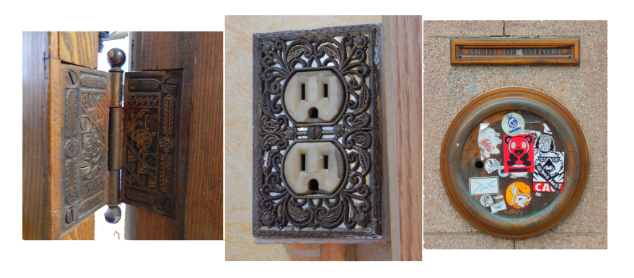If you’ve ever been in our store, you’re likely to have noticed some features not often seen in retail spaces. Details like the marble bar that runs through the center of our shop like a spine, or the depositors’ station now home to yummy smelling soaps, or the not-so-subtle hint on the Broadway facade. Evidently, our building was a bank for a very long time. The current 368 Broadway building was constructed in 1902 following the fatal Arcade fire that claimed 5 lives and left only a shell of the Citizens National Bank.1, 2 (For more local history, check out the book, Saratoga Lost. For other bits of historical narrative, check out the Saratoga Tours guidebook.)
This whole section of the block was rebuilt. Some years later the Citizens National Bank and another local bank, The First National Bank, consolidated under the name Saratoga National Bank.3,4 The company soon purchased the building from the Putnam family, yes that Putnam family.5 Sometime in the 1930s the bank initiated a remodeling project and gave us the embellishments we appreciate today.6
Architecturally, the Saratoga National Bank was designed in the Art Deco style.7 More technically, it falls with the commercial classical style (Saratoga Springs Preservation Foundation). In a study of Art Deco architecture, architect Ely Jacque Kahn wrote that it was a, “…modern but not Modernist architecture. It developed from the application of Deco ornament to classical or Modernist buildings into a new kind of building capable of expressing the aspirations of dynamically developing consumerist societies.”8 All that to say, when the owners of the Saratoga National Bank decided to engage in some renovations, they incorporated many bits and pieces of classical design. Such details impress folks with notions of grandeur and longevity, hopefully instilling confidence in the institution. This would have been especially significant, when you recall that all of this renovation and remodelling was occurring at the tail end of the Great Depression.
The Preservation Foundation here in town describes its deco features as fluted pilasters, segmental arched recesses, rusticated stone cornices, round arch classical windows, and quoins. For example, there are small touches within and outside of the building using “stylized papyrus and lotus blossoms” that adorn the entablatures.9 A quick online search suggests that lotus blossoms symbolize life and renewal and papyrus pillars mythologically “hold up the sky.”10 That’s a pretty profound statement for your bank to make! That the bank survived the ‘30s, I think, rather meant they earned the right to use symbols of renewal and strength.
As the years continued, Saratoga National Bank’s ability to navigate the business rose and fell, and in 1960 it merged with the State Bank of Albany. A decade or so later, it moved its offices, leaving the premises at 368 vacant. Another business moved in and a new institution found its home in downtown Saratoga: the well-beloved Barclay’s Tavern and Restaurant. The owners maintained and played up the old bank features as much as they could. The black marble teller’s bar became the host of many a Long Island Iced Tea Night. Evidence of activity here still exists in our floors, as you can find bits of glass wedged into the cracks and pits.11 (Check out the glasswares you can get now to commemorate your time in Saratoga.)
Speaking of — a marble specialist once walked into a bar.. Just kidding, the punchline is that he was immediately impressed with our tiling and told us to look up travertine. Having done so, I can tell you that travertine is a sedimentary rock formed by hot springs depositing mineral-rich layers.12 The chemistry and heat surrounding its formation makes for a very dense material, which then becomes useful in a variety of ways, including construction. Interesting to note, the formation of travertine is similar to that of tufa, the mineral-rich deposits found in cool springs. Examples of this sort can be found at any of Saratoga’s famous mineral springs. The nature of its deposits, chalky and porous, prevents it from being useful in the same ways as travertine.
The origin of the marble bar, unfortunately, has been a bit harder to nail down. Speculation abounds, and disinterested in misinformation, I will leave that topic be for now. I do, however, want to share some other banking remnants with you that most people simply overlook, or cannot access.The old thermometer still adorns the wall outside of our front door, though it does not function anymore. The night-deposit box remains, though modern urban life has taken its toll. The old vaults still exist. Ours in the basement thoroughly protects our garments. The one in the hall had to be sealed shut after an accident left a man short several fingers. Smaller hints of grandeur quietly await appreciation as well. Outlet covers and door hinges have been some of my favorite discoveries in the shop.
There is so much more history to tell about this block, before the days of Saratoga National Bank, as well as after the heyday of Barclay’s. We may revisit the 19th century another time. Mare will be discussing our Impressions history soon, as we prepare to celebrate our 40th Anniversary!
Special Thanks to the staff at the Saratoga Room in the Saratoga Springs Public Library, as well as Samantha Bosshart of the Preservation Foundation. I very much appreciate your help, enthusiasm, and knowledge. I look forward to more conversations.
1 Saratoga Springs City Fire Records, 1902. Saratoga Room, Saratoga Springs Public Library
2 Fire 4th on Site; 1902 Blaze Took 5 Lives, Saratogian, 4/18/66.
3 Albany Evening Journal, 10/30/1915, page 11.
4 Not the same company as the modern Saratoga National Bank. See https://www.saratoganational.com/About, est. 1988.
5 Nancy Putnam Andrews, daughter of Gideon Putnam, owned this block in the 1800s, living on the second floor, as well as constructing a grand meeting and entertainment hall in the building. It was known as St. Nicholas Hall, and later, Putnam Music Hall, and still later, Saratoga Theater. “Fires destroy theaters, but not rebirths” by Bea Sweeney. Saratoga Room, Saratoga Springs Public Libary. “Barclay’s, Bank to Bar” by Helen Edelman Ward. Saratoga Room, Saratoga Springs Public Library.
6 Barclay’s, Bank to Bar, Ward.
7 Kettlewell, James. Saratoga Springs, an Architectural History, 1991, page 167.
8 Editors: Benton, Benton, Wood. Art Deco 1910-1939, page 258.
9 Saratoga Springs Preservation Foundation, Building-Structure Inventory Form, 1976.
10 Ancient Egypt: the Mythology. Lotus symbolism, ; Papyrus symbolism.
11 Barclay’s, Bank to Bar, Ward.
12 Gandin, Anna & Capezzuoli, Enrico (2008) Travertine versus Calcareous tufa.





